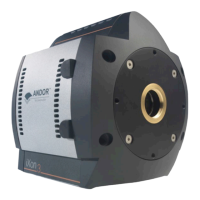Page 31
Features & Functionality
3.3.5.2 - Baseline Clamp
Whenacquiringdatasmallchangesintheambienttemperatureand/orintheheatgenerationofthedrivingelectronics
within the camera may cause some drift in the baseline level. This is most often observed during long kinetic series.
Any drift in the baseline level can be corrected by using the Baseline Clamp option. Baseline Clamp corrects each
individual image for any baseline drift by subtracting an average bias signal from each image pixel and then adding 100
counts to ensure that the displayed signal level is always a positive number of counts.
NOTE: Before activating Baseline Clamp, please ensure that the baseline level is above zero counts for the
cooling temperature selected.
3.3.6 - Binning and Sub Image options
Binning is a process that allows charge from two or more pixels to be combined on the EMCCD-chip prior to readout.
Summing charge on the EMCCD and doing a single readout gives better noise performance than reading out several
pixels and then summing them in computer memory. This is because each act of reading out contributes to noise. There
are two types of the binning as follows:
• Vertical Binning: Where charge from two or more rows of the EMCCD-chip are moved down into the shift
register before the charge is read out. The number of rows shifted depends on the binning pattern selected.
Thus, for each column of the EMCCD-chip, charge from two or more vertical elements is summed into the
corresponding element of the shift register. The charge from each of the pixels in the shift register is then
shifted horizontally to the output amplier and read out.
• Horizontal Binning: Where charge from two or more pixels in the serial register are transferred into the output
amplier and read out as one combined data value. Thus the charge from two or more of the horizontal
elements is effectively summed into the output amplier before being readout.
Combiningboththeverticalandhorizontalbinningmethodsproduces“Superpixels”.Theseconsistoftwoormore
individual pixels that are binned and read out as one large pixel. Thus the whole CCD, or a selected sub-area becomes a
matrix of Superpixels, e.g.:
Thehorizontalandverticalbinningparametersdeterminethedimensionsofanysuperpixelscreated.Ontheonehand
superpixels result in a loss of spatial resolution when compared to single pixel readout, but on the other hand they offer
the advantage of summing data on-chip prior to readout thereby producing a better signal to noise ratio and a higher
framerate.AlliXon3modelsoffercompletelyexiblebinningpatternswhichareuser-selectablefromsoftware.
For the purpose of initial focusing and alignment of the camera, or to increase the readout speed, the user may wish to
only readout a particular sub-area of the CCD to produce a Sub Image.
When a sub image has been dened, only data from the selected pixels will be digitized. Data from the remaining pixels
willbediscarded.TheexiblecongurationoftheiXon3allowstheusertosettheSub Image area to any size and
location on the CCD chip.

